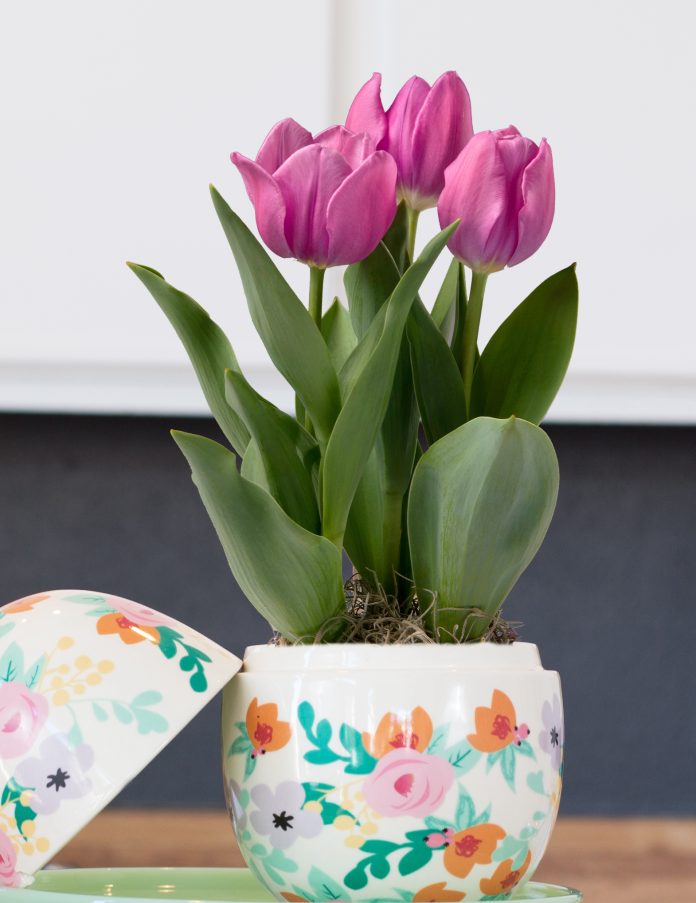-Erl-, Saskatchewan Perennial Society
My younger brother, who lives in Sidney just north of Victoria, BC, taunts me every February with pictures of flowering daffodils and tulips. But I have an answer to that and can enjoy flowering spring bulbs as early as January while there’s still snow on the ground with the constant threat of -30C or colder.
The trick to ‘forcing’ bulbs to flower out of season is realizing that when planted outdoors in the fall, bulbs are not completely dormant. During the late fall and early spring, when the soil is cold but not frozen, bulb roots and flower buds are developing. You need to replicate this in your home by planting them in moist potting mix and maintaining cold (but not frozen) conditions. By fooling them into thinking they have spent a winter outdoors, they will be just as anxious to bloom as you are to enjoy them.
• Bulb quality matters: Purchase large good quality bulbs as soon as they are available from stores, by mail order or online. Avoid shrivelled, damaged and undersized bulbs. If possible, select shorter or miniature cultivars.
• Pot size: The traditional pot choice is a bulb pan – wide and short – usually 7.5 centimetres (3 inches) high. The wide base make tipping over less likely when growing taller plants. Smaller bulb species (e.g. crocus) are fine in slightly taller pots as they don’t require the extra stability. But ultimately, any pot will suffice as long as it provides sufficient depth and has good drainage.
• Pot depth: The pot needs to be deep enough to have at least 5 centimetres (2 inches) of potting mix PLUS the height of the dormant bulbs. Choose a deeper pot if the bulb will stick above the pot rim (exception: amaryllis).
• Potting up: Add at least 5 centimetres (2 inches) of sterile soil-less potting mix, leaving enough room for the bulb to sit just below the pot rim when planted on top of this first layer. Fill the pot for an impressive display: pointed tip up, leaving 1-2 centimeters (0.5-1 inch) between bulbs. Cover all but the tips with additional potting mix. Water well and allow them to drain completely. Label with the species/variety, planting date and the date when the chilling period will be complete. Tip 1: Plant only one variety of one species per pot: a mixed pot is unlikely to bloom in unison. You can still have a mixed effect, by using multiple pots with separate species and varieties. Tip 2: Space out planting dates to extend the length of time you’ll have spring flowers beautifying your home.
• Temperature: Bulbs need consistent chilling temperatures (2-7C / 35-45F). Not many of us have a root cellar or a cold room anymore, but your refrigerator provides an ideal environment (but avoid storing them with apples, avocadoes, bananas, blueberries, cantaloupes and other ethylene producing fruits). An attached garage may work, but the temperature may fluctuate too much (too warm to excessively cold) which will lead to poor results.
• Chilling period: Chill your pots in the dark for 12-20 weeks (see below for species-specific chilling period). If you cut the time short, the plants and flowers may end up stunted and distorted.
• Inspect regularly: Water to keep the potting mix slightly damp but not wet. If kept too wet, mold and rots may develop. Remove diseased bulbs. Bulbs may start growing before their ‘official’ chilling period is over – move to step 8. when shoots are 5-8 centimetres / 2-3 inches long.
• End of chilling period: Bring the pots into a cool and bright location but avoid full sun. If they haven’t started growing already, it may take 2-3 weeks for the bulb to send up shoots and flowers. When the buds start showing a bit of colour, move the pots into a warmer and brighter location. But keep in mind the warmer the location, the shorter their bloom period.
Recommended weeks of chilling
Amaryllis: no chilling required, but may take 6-8 weeks to flower after planting.
Crocus: 15 weeks
Daffodils: 15-17 weeks
Grape hyacinth (Muscari): 14-15 weeks
Hyacinths: 11-14 weeks, although it is possible to purchase pre-chilled bulbs. Just pot these up and wait for the blooms.
Paperwhites: no chilling required.
Squill (Scilla): 12-15 weeks
Tulips: 14-20 weeks
TULIP TIP 1: Face the flat side of the tulip bulb towards the outside of the pot so the first leaf grows towards the outside for an attractive and tidy look.
TULIP TIP 2: Remove the brown papery covering (optional).
Erl gardens in Saskatoon. This column is provided courtesy of the Saskatchewan Perennial Society (SPS; saskperennial@hotmail.com). Check our website (www.saskperennial.ca) or Facebook page (www.facebook.com/saskperennial) for a list of upcoming gardening events


